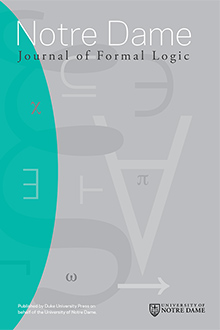We show that, under , a coherent Suslin tree forces that every two Aronszajn trees are club-isomorphic.
References
[4] Farah, I., “OCA and towers in $\mathcal{P}(N)/\mathrm{fin}$,” Commentationes Mathematicae Universitatis Carolinae, vol. 37 (1996), pp. 861–66. MR1440716[4] Farah, I., “OCA and towers in $\mathcal{P}(N)/\mathrm{fin}$,” Commentationes Mathematicae Universitatis Carolinae, vol. 37 (1996), pp. 861–66. MR1440716
[5] Fischer, A., F. D. Tall, and S. Todorčević, “PFA(S)[S] implies there are no compact S-spaces (and more),” Topology and Its Applications vol. 195 (2015), pp. 284–296.[5] Fischer, A., F. D. Tall, and S. Todorčević, “PFA(S)[S] implies there are no compact S-spaces (and more),” Topology and Its Applications vol. 195 (2015), pp. 284–296.
[8] Kunen, K., Set Theory: An Introduction to Independence Proofs, vol. 102 of Studies in Logic and the Foundations of Mathematics, North-Holland, Amsterdam, 1980.[8] Kunen, K., Set Theory: An Introduction to Independence Proofs, vol. 102 of Studies in Logic and the Foundations of Mathematics, North-Holland, Amsterdam, 1980.
[11] Larson, P. B., and F. D. Tall, “Locally compact perfectly normal spaces may all be paracompact,” Fundamenta Mathematicae, vol. 210 (2010), pp. 285–300. MR2733053 10.4064/fm210-3-4[11] Larson, P. B., and F. D. Tall, “Locally compact perfectly normal spaces may all be paracompact,” Fundamenta Mathematicae, vol. 210 (2010), pp. 285–300. MR2733053 10.4064/fm210-3-4
[12] Larson, P. B., and F. D. Tall, “On the hereditary paracompactness of locally compact, hereditarily normal spaces,” Canadian Mathematical Bulletin, vol. 57 (2014), 579–84. MR3239121 10.4153/CMB-2014-010-3[12] Larson, P. B., and F. D. Tall, “On the hereditary paracompactness of locally compact, hereditarily normal spaces,” Canadian Mathematical Bulletin, vol. 57 (2014), 579–84. MR3239121 10.4153/CMB-2014-010-3
[13] Larson, P. B., and S. Todorčević, “Chain conditions in maximal models,” Fundamenta Mathematicae, vol. 168 (2001), pp. 77–104. MR1835483 10.4064/fm168-1-3[13] Larson, P. B., and S. Todorčević, “Chain conditions in maximal models,” Fundamenta Mathematicae, vol. 168 (2001), pp. 77–104. MR1835483 10.4064/fm168-1-3
[14] Larson, P. B., and S. Todorčević, “Katětov’s problem,” Transactions of the American Mathematical Society, vol. 354 (2002), pp. 1783–91. MR1881016 10.1090/S0002-9947-01-02936-1[14] Larson, P. B., and S. Todorčević, “Katětov’s problem,” Transactions of the American Mathematical Society, vol. 354 (2002), pp. 1783–91. MR1881016 10.1090/S0002-9947-01-02936-1
[17] Moore, J. T., M. Hrušák, and M. Džamonja, “Parametrized $\diamondsuit$ principles,” Transactions of the American Mathematical Society, vol. 356 (2004), pp. 2281–306.[17] Moore, J. T., M. Hrušák, and M. Džamonja, “Parametrized $\diamondsuit$ principles,” Transactions of the American Mathematical Society, vol. 356 (2004), pp. 2281–306.
[18] Morgan, C., and S. G. da Silva, “Almost disjoint families and ‘never’ cardinal invariants,” Commentationes Mathematicae Universitatis Carolinae, vol. 50 (2009), pp. 433–44.[18] Morgan, C., and S. G. da Silva, “Almost disjoint families and ‘never’ cardinal invariants,” Commentationes Mathematicae Universitatis Carolinae, vol. 50 (2009), pp. 433–44.
[21] Tall, F. D., “$\mathrm{PFA}(S)[S]$: more mutually consistent topological consequences of $\mathrm{PFA}$ and $V=L$,” Canadian Journal of Mathematics, vol. 64 (2012), pp. 1182–200. MR2979581 10.4153/CJM-2012-010-0[21] Tall, F. D., “$\mathrm{PFA}(S)[S]$: more mutually consistent topological consequences of $\mathrm{PFA}$ and $V=L$,” Canadian Journal of Mathematics, vol. 64 (2012), pp. 1182–200. MR2979581 10.4153/CJM-2012-010-0
[29] Yorioka, T., “A non-implication between fragments of Martin’s axiom related to a property which comes from Aronszajn trees,” Annals of Pure and Applied Logic, vol. 161 (2010), pp. 469–87. Correction, Annals of Pure and Applied Logic, vol. 162(2011), pp. 752–54.[29] Yorioka, T., “A non-implication between fragments of Martin’s axiom related to a property which comes from Aronszajn trees,” Annals of Pure and Applied Logic, vol. 161 (2010), pp. 469–87. Correction, Annals of Pure and Applied Logic, vol. 162(2011), pp. 752–54.
[30] Yorioka, T., “Uniformizing ladder system colorings and the rectangle refining property,” Proceedings of the American Mathematical Society, vol. 138 (2010), pp. 2961–71.[30] Yorioka, T., “Uniformizing ladder system colorings and the rectangle refining property,” Proceedings of the American Mathematical Society, vol. 138 (2010), pp. 2961–71.





